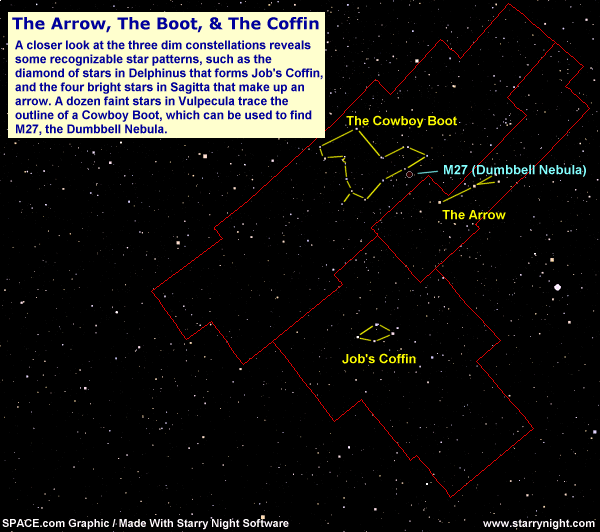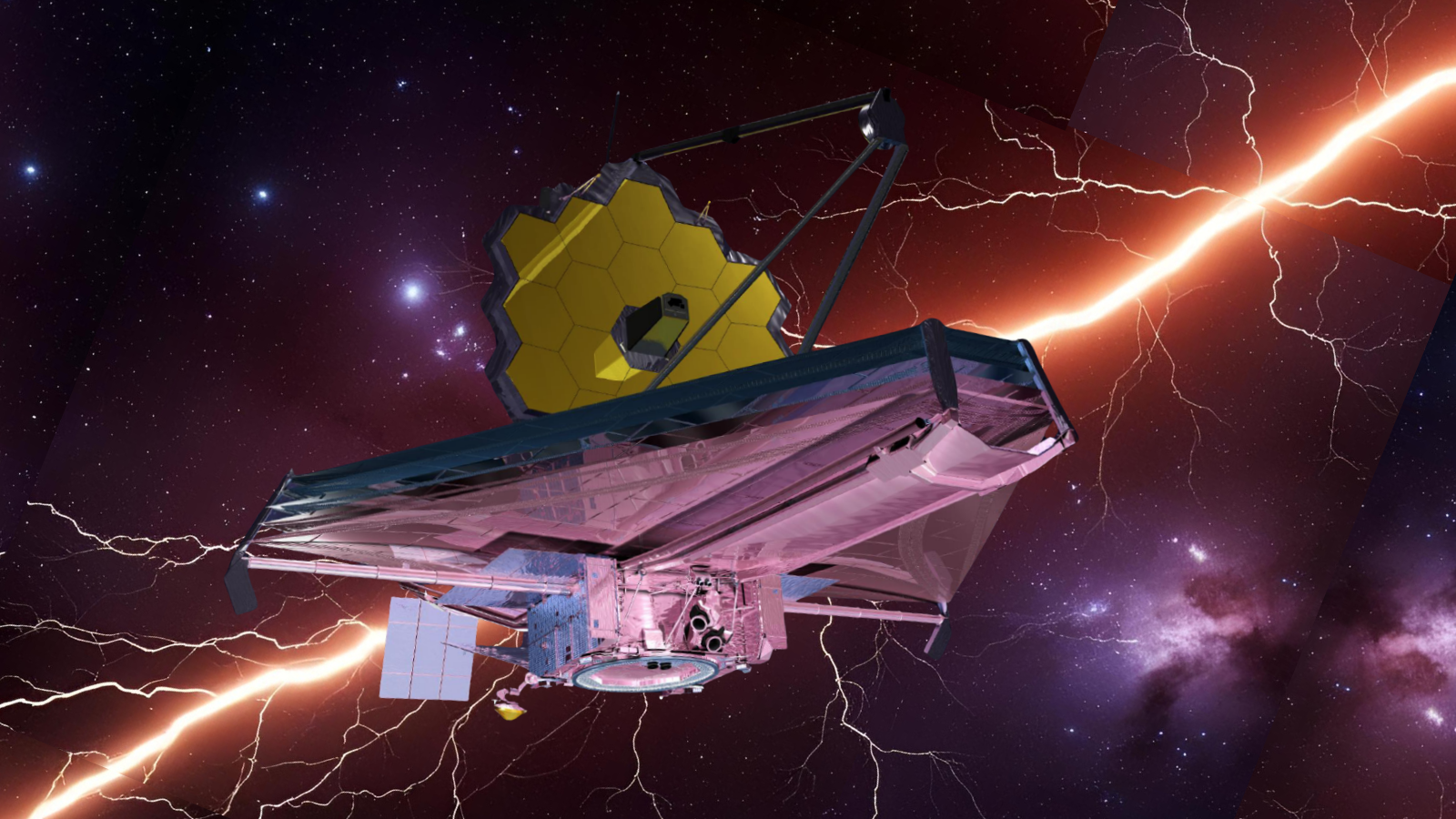Top 10 Summer Sky Objects to See Before Fall

As the summer night sky draws nearits close, there are still some cosmic objects that may beckon skywatchersequipped with a small telescope, binoculars or their own two eyes.
Compiling such a list is, ofcourse, very subjective, but here (with apologies to David Letterman) is my own?Top 10? list of summersky objects to try and catch before they're gone. They are listed inascending order of merit from this seasoned stargazer:
10)?The Cowboy Boot
It?sa fact: Thumb through most astronomy books or skywatching guides and you?llfind all the accolades going to the most brilliant and splashy star patternssuch as Orion, the Hunter, Scorpius, the Scorpion or (for southern observers),the region around Crux, the Southern Cross.?
Butwhile the small, faint star patterns usually get short shrift, there?s onepattern I always look for, partly because it serves as an excellent gage fordetermining the quality of the night sky and also because it serves as a?pointer? to one of the summer?s best deep-sky objects.
It's nicknamed the Cowboy Boot. Thissky map shows where to look for it.
This star arrangement appears in theconstellation Vulpecula, the Little Fox, which on most charts seems to benothing more than a formless splattering of dim stars. But astronomer HughRice, who more than a half ?century ago used to work at New York?s HaydenPlanetarium, showed part of this group - on his star maps - resembled a cowboyboot.?
Breaking space news, the latest updates on rocket launches, skywatching events and more!
The boot even boasted a spur thatmany cowboys wear.
9) The Dumbbell
Sighted in wide-field binoculars ora telescope?s viewfinder, Rice?s cowboy boot pattern helps us locate thebeautiful Dumbbell nebula (M27). Picked up with very low power as a glowingbubble encompassing two hazy patches of light; it assumes a dumbbell appearancein larger telescopes.?
The name "Dumbbell" was, in fact,derived from the description by the Rev. T.W. Webb (1807-1885) of ?two hazymasses in contact.? And while you?re scanning in this area of the sky, be sureto also look for the Arrow (Sagitta) and Job?s Coffin, a lozenge-shape patternof four stars that represents Delphinus, the Dolphin.
8) A Ghostly Doughnut
The little constellation of Lyra issupposed to represent Apollo?s harp. Six fainter stars form a little geometricpattern of a parallelogram attached at its northern corner to an equal-sidedtriangle.? Vega gleams at the western part of the triangle. But tucked in thisregion is the acclaimed Ring nebula.
The two lowest stars in theparallelogram are Beta and Gamma Lyrae. Beta is sometimes also known asSheliak. Between these two stars, but a trifle nearer to Gamma, is where youwill find the Ring nebula.?
Thissky map shows the location of the Ring nebula in the Lyra constellation.
The nebula shines at magnitude+8.8, and thus is far too faint to be seen with the unaided eye.? Any good pairof binoculars will locate it, though it will look almost star-like inappearance because of its small apparent diameter.?
The ring shape might just begin tobecome evident to most eyes in small telescopes using a magnification of100-power, although at least a 6-inch telescope is recommended to see the ringclearly. With larger instruments and higher magnifications, the ring appearsdistinctly as a ?tiny ghostly doughnut.??
7) Draco the Dragon
While most folks are familiar withthe Big and Little Dipper, in the same region of the sky is a long, windinggroup of stars which portrays the mythological creature of a dragon namedDraco, which during late evening hours is riding high above Polaris, the NorthStar.?
Thissky map shows thelocation of the constellation Draco in early September.
Draco is a very ancient star grouping.The earliest Sumerians considered these stars to represent the dragon Tiamat. Laterit became one of the creatures that Hercules killed. One of Draco?s tasks wasto guard the garden of Hesperides and its golden apples that Hercules wassupposed to retrieve. In the stars, Draco coils around Polaris and we now seeHercules standing (albeit upside down) on Draco?s head.?
The Dragon's head is the mostconspicuous part of Draco: an irregular quadrangle, not quite half the size ofthe Big Dipper's bowl. The brightest star is Eltanin, a second magnitude star,shining with an orange tinge.? Interestingly, a number of temples in AncientEgypt were oriented toward this star.?
The faintest of the four stars inthe quadrangle, however, is worth looking for: Nu Draconis, a wonderful double-starfor very small telescopes. The two stars are practically the same brightness,both appearing just a trifle brighter than fifth magnitude and separated byjust over one arc minute (or about 1/30th the apparent diameter of a full moon).?
6) The "Double-Double" Star
Back to the constellation of Lyraonce again, this time for a look at another double-star. In fact, you couldalmost call this one "Nu Draconis squared."
Epsilon Lyrae is better known asthe "double-double" star. Exceptionally good vision on a clear, darknight will reveal Epsilon as undoubtedly two tiny stars (designated Epsilon 1and Epsilon 2) that are very close together.
The separation is approximatelyone-ninth the apparent diameter of the full moon. This feat is probably rightat the limit of perfect vision.
Binoculars will make the two starsclearly visible. But if you train a smalltelescope on them, then eachof these two stars are themselves shown to be double-stars.
So here, in what initially mightappear as a single speck of light in the sky, we have a system of four stars,revolving intricately about each other. The two stars that make up Epsilon 1take at least several hundred years or more to orbit each other. An even longerinterval of nearly a thousand years has been assigned to the two stars thatmake up Epsilon 2.?
Meanwhile, both pairs of starsappear to be revolving about each other and have a common center of gravitywith a period that probably is on the order of a million years or more,
5) The Wild Ducks
Several clouds of stars surroundedby a few dark regions for contrast can be seen with binoculars in the brightarea of the Milky Way about halfway between the star Altair and theconstellation of Sagittarius.?
Four faint stars in a stretched-outdiamond are about all that is visible of Scutum, the Shield. One of the MilkyWay?s great star clouds is also within Scutum.
Near the northern star of theShield is the 11th entry in Charles Messier?s famous catalogue of ?fuzzy?objects masquerading as comets.? Messier 11 is one of the richest and mostcompact of galactic clusters, described by one experienced observer as resembling"a flight of wild ducks."
4) A Cosmic Chrysanthemum
Quite possibly the most celebratedobject in the summertime skies is the Great Cluster in Hercules, known also asM13. Anyone who has visited the summer gathering of amateur astronomers nearSpringfield, Vt., known as Stellafane, know that this famous cluster is oftenon display in the observatory that houses the famed Porter turret telescope.
To locate M13, look toward the fourstars, known as the ?Keystone,? which supposedly forms the body of Hercules. It?sbetween the two western stars of the keystone that we can find the Great GlobularCluster of Hercules about a third of the way along a line drawn from the starsEta to Zeta.
Thissky map shows the cluster's approximate position.
Actually, it was not Messier, butSir Edmund Halley (of comet fame), who first mentioned it in 1715, havingdiscovered it the previous year:? ?This is but a little Patch,? he wrote, ?butit shows itself to the naked Eye, when the Sky is serene and the Moon absent.?
Located at a distance of about25,000 light years, the Hercules Cluster has been estimated to be a ball oftens of thousands of stars roughly 160 light years in diameter.???
If you use good binoculars and looktoward that spot in the sky where M13 is you likely will see a similar view: aroundish glow or patch of light.? Moving up to a telescope, the viewdramatically improves.? With a 4 to 6-inch telescope, the ?patch? starts tobecome resolved into hundreds of tiny pinpoints of light. In largerinstruments, M13 is transformed into a spectacular celestial chrysanthemum
3) The Coat Hanger
Most amateur astronomers have heardof such beautiful open star clusters as the Pleiades, Hyades and the Beehive. Yetfew have ever heard of the "Coat Hanger."?
But if you turn your binoculars tothe region of the sky roughly halfway between the bright stars Vega and Altair,?you will discover this intriguing group of stars. It is not ?too far away fromthe Cowboy Boot of Vulpecula that was number 9 on our list.?
Thissky map shows the Coat Hanger's position in relation to other nearby skytargets.
For some reason that I have neverbeen able to fathom, the Coat hanger Cluster is rarely mentioned, if at all, inmost popular astronomy books. Yet, it is the brightest of all the star clustersin this part of the sky!
However, it only appears as aproper coat hanger only for Southern Hemisphere observers, where it appearsright side up. In a clear, dark sky you might even perceive it with the nakedeye as a fuzzy patch of light. This is one object ?best suited for yourbinoculars; even a small telescope with low power will provide too muchmagnification and will cause the stars to appear too widely spaced apart.
2)?Albireo: Blue and Gold
Without question, this is one of ? ifnot the most beautiful ? double-stars in the night sky. Located in theconstellation of Cygnus, the Swan, Albireo supposedly marks the swan?s beak.
A smalltelescope or even a pair of steadily held binoculars will readily split Albireointo two tiny points of light of beautiful contrasting colors: the brighter onea rich yellowish-orange, the other a deep azure blue, both placed very closetogether.
An absolutelystunning view will come with a telescope magnifying between 18 and 30 power.Albireo is believed by astronomers to be a physical pair, although there hasnever been evidence of any orbital motion between these two colorful stars. Theprojected separation between the two is just over 400 billion miles. At least55 of our solar systems could be lined-up edge-to-edge, across the space thatseparates the components of this famous double star.
1)?Our Milky Way Galaxy
Summertime is undoubtedly the besttime to observe the beautifulMilky Way. With a good pair of binoculars or a telescope you can nowobserve millions of sparkling little stars that make up this glowing, irregularbelt of luminosity.
On early summer evenings it appearsto arch from the north-northeast to the south-southeast, with its brightest andmost spectacular region running across the Summer Triangle and beyond towardthe south-southeast horizon.
There appears to be a great blackrift dividing it into two streams, beginning with Cygnus and extending downtoward the south. Also in Cygnus is the black void known as the Northern CoalSack.? This Coal Sack and the Rift are not holes in the Milky Way, but rather arevast clouds of dust ?floating? out in interstellar space which present a solidand impenetrable curtain between us and the more distant stars.?
Never visible from large citieswith their bright lights, smoke and haze, the Milky Way can still be readilyviewed from distant suburbs and rural locations. Before the invention of thetelescope, the true nature of the Milky Way Galaxy ("Gala" is Greekfor milk) was a mystery.
The brightest part of the Milky Wayis in the constellation of Sagittarius, near the star El Nasl. In fact, thisregion is roughly our galaxy?s center.
Even to the unaided eye, the viewis one of excitement and beauty. The Sagittarius Star Cloud, about 30,000 light-yearsdistant, seems to be the nucleus, with the sun and all the outer stars of thegalaxy revolving around it at the rate of 155 miles per second.? It apparentlyrequires about 200 million of our Earth years to make one complete revolution,or one "cosmic year," around the center of our galaxy.
- Gallery - Amazing Milky Way Photos
- Telescopes for Beginners
- For Star-Gazers, September Brings New Night Sky
Joe Rao serves as an instructor and guest lecturer at NewYork's Hayden Planetarium. He writes about astronomy for The New York Times andother publications, and he is also an on-camera meteorologist for News 12Westchester, New York.

Joe Rao is Space.com's skywatching columnist, as well as a veteran meteorologist and eclipse chaser who also serves as an instructor and guest lecturer at New York's Hayden Planetarium. He writes about astronomy for Natural History magazine, Sky & Telescope and other publications. Joe is an 8-time Emmy-nominated meteorologist who served the Putnam Valley region of New York for over 21 years. You can find him on Twitter and YouTube tracking lunar and solar eclipses, meteor showers and more. To find out Joe's latest project, visit him on Twitter.
